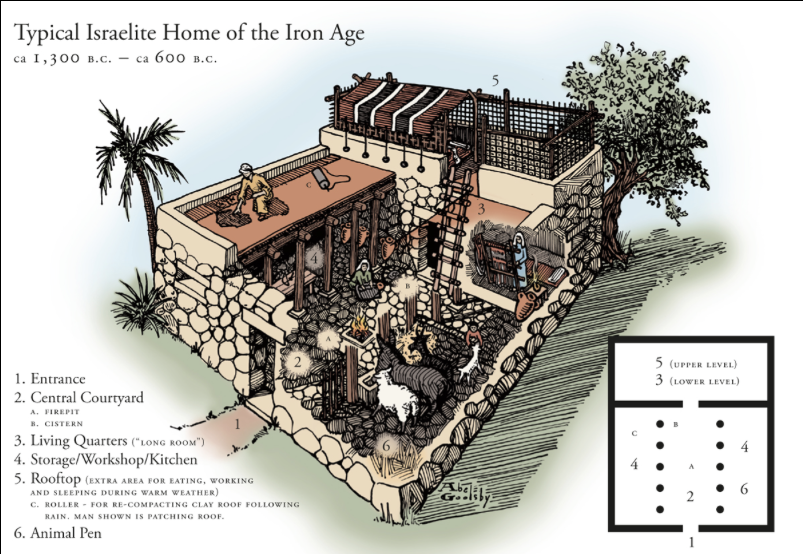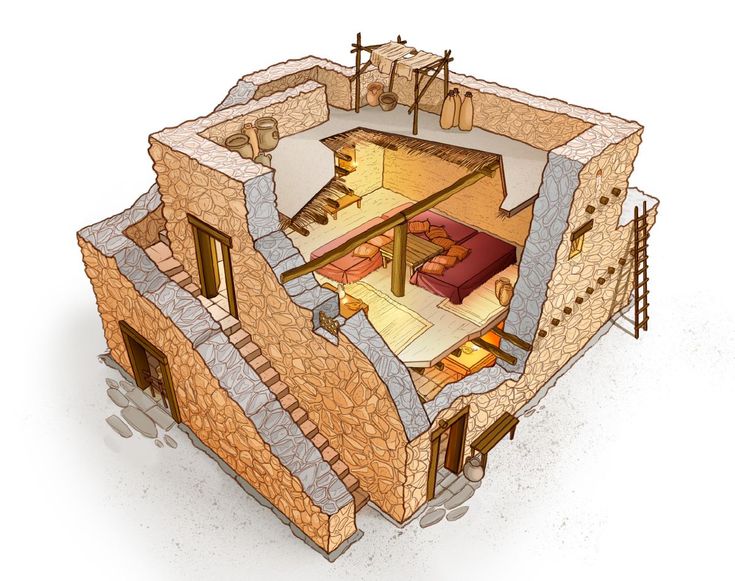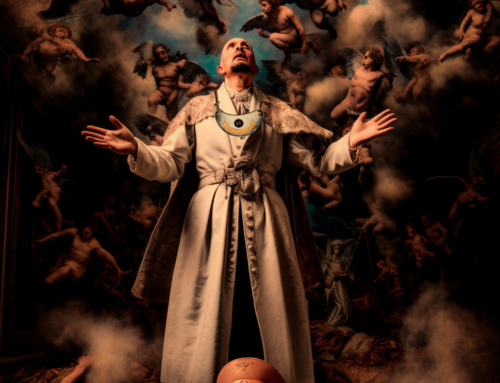Most of our mental imagery about Jesus’ birth in Bethlehem is grounded in the culture and conditions of medieval Europe. Our creche tableaus are rooted in the first stable scenes set up by St Francis in the thirteenth century and feature a European type stable-barn-cattle shed. The “inn” is a typical European tavern, inn, rustic hotel and the “grumpy innkeeper” probably entered the story from medieval mystery plays. My point is that, after researching my book The Secret of the Bethlehem Shepherds it became clear that the real historical details were not only very different, but also carried much more significance when fully understood.
Much of the misunderstanding revolves around the “inn” of Bethlehem. The word translated as “inn” in our English translations is the Greek word kataluma. This word, like many words in ancient languages, carries multiple meanings. It basically means “a temporary lodging place”. So it could mean an “inn” or a “guest room” in an ordinary home. To hone in on what Luke means in his infancy narrative one needs to put the story in a wider context.
In her study of travel in the ancient world Sabine Huebner records that along the official Roman roads, spaced about ten miles apart, there was a network of relay stations called mutationes. These were relay stations– places to change horses and pack animals.
Spaced about 25 miles apart were mansiones—guesthouses that offered free accommodation for guests on official business. In addition to the official mansiones there were also public hostelries. St Luke uses the Greek word pandocheion for this kind of inn in the story of the good Samaritan.“These inns, also called katagōgia in Greek, were located along the main transport routes and were often found on the outskirts of cities or larger villages. They provided travelers from the lower social strata with cheap, hot meals and basic accommodation. Pandocheia were widely viewed as disreputable by ancient authors.” Huebner goes on to explain how these inns were known for “drunken guests, adulterated wine, brawls, theft and prostitution.” Quoting classical authors of the time she says, “It was not uncommon for a landlord’s daughter to sell her body as well as wine and a hot meal to travelers.”
Archeologists estimate that the population of Bethlehem at the time of Jesus’ birth was between 300 and 1000. Because of Bethlehem’s small size, it would not have included a safe and official mansione which were only located on the main Roman roads, and were only available to travelers on official imperial business. If Bethlehem did have a more basic hostelry—given the reputation of the pandocheia, it would not have been a likely place for St Joseph, a just and righteous man, to have sought shelter for his betrothed and pregnant young wife.
Furthermore, the Middle Eastern culture–today as well as 2000 years ago–is noted for its hospitality. In Bedouin culture, for example, one must offer food and shelter to anyone who turns up a the door–even a sworn enemy. Considering that Bethlehem was Joseph’s home town it is inconceivable that he and his young pregnant wife would have been homeless. They would most certainly have approached a relative living in the town and they most certainly would not have been turned from the door.
Now this is where the word kataluma becomes really interesting. We know from archeologists and historians that the typical peasant home in Judea of the time was a one roomed structure of mud bricks usually built in front of a cave–which was used for storage and stabling. The house had a flat roof with a stairway to one side of the house for access. The roof was an extra living space perhaps with a trellis for a vine which provided grapes and shade. On the upper level there was an extra room for guests. This is likely what kataluma in the infancy narrative is referring to. This meaning is corroborated by Luke’s use of kataluma for the Upper Room Jesus used for the Last Supper. (Remember Luke used the word pandocheion when referring to a traveler’s inn in the story of the Good Samaritan)
You might wonder why a family crammed into a one room house with a cave as a back storage/stable room would have the luxury of an extra room above. There are several reasons. First, it emphasizes the importance of hospitality in their culture. Second, it was regarded sometimes as “the prophet’s room”. Check out I King 17 where the itinerant prophet Elijah shelters in the extra room of the widow of Zarepath. But there is a third, fascinating use for the guest room which emerges from a study by the word by New Testament scholar Stephen Carlson.
He learned that the upper room was also added to the house on the marriage of the householder’s son, and the Upper Room was used as the bridal chamber. This is the allusion in John 14 where Jesus says, “In my Father’s house are many rooms and I go to prepare a place for you, and if I go away to prepare a place for you I will come again and take you to myself…” This saying has its full meaning within the context of the marriage customs of the time. A betrothal would take place in the fiancée’s home with both families present. Then the bride to be and her family would prepare for the wedding. The groom to be would return to his family home and, with his friends, build the extra chamber on the top level of his father’s house. When the wedding day arrived the groom would process to the bride’s family home where the bride and her bridesmaids would be waiting for them. (Thus the parable of the virgins with their lamps) The groom would come. The marriage would take place and he would take the bride home to his father’s house where–in the kataluma the marriage would be consummated and their married life would begin. The kataluma therefore was reserved, not only for guests, but for this special part of the marriage ritual. Carson argues that the kataluma in Luke’s infancy gospel is not only not a traveler’s inn, and not only an ordinary guest room, but a very special kind of guest room.
By the way, some folks might say about the reference to the prophet’s room and I Kings 17–“That was a long time before the birth of Jesus and things were very different then.” Maybe, but one doesn’t need to dig very far into the culture and conditions of first century Judea to realize how stubborn and long lasting the customs and traditions of that culture are. So, for example, when we were traveling in Jordan a few years ago I noticed that many of the modern homes seemed to be unfinished. The first level was done, but sticking up from the flat roof were concrete pillars as if the house was unfinished. I asked our Jordanian guide why so many houses were seemingly left incomplete. Did so many people run out of money before completing the house? “No” He answered. “We have a custom here that a man leaves the top level of his house unfinished until his oldest son is married. Then the son and his friends complete the second floor and he comes to live there with his bride after their wedding.”
That there was “no place for them in the kataluma” therefore may be an oblique and tactful reference to the awkwardness of Joseph and Mary’s situation. Typically a man would return to his father’s house in his home town to complete the marriage if the betrothal took place elsewhere. However, in Mary and Joseph’s case it was not appropriate for them to use the kataluma. Mary was already pregnant. The relatives of Joseph therefore fulfilled their obligation to offer hospitality, but also recognized the apparently shameful situation of Mary and Joseph by offering them shelter in the warm, adjacent back room which was the cave used for stabling and storage.
This understanding of kataluma also adds weight to Luke’s use of the word for the room where the Last Supper was held. Note that Jesus’ words about “In my father’s house are many rooms” takes place during the Last Supper. In a kataluma often used as a bridal suite, Jesus refers to the kataluma that a bridegroom would build for his bride and refers to his “coming again to take them to himself”. This affirms and corroborates the nuptial imagery that occurs throughout the gospels–in which in his sayings and parables Jesus regularly refers to himself as the bridegroom and we, as the church, his bride.
I therefore do not think it is stretching this too far to see that Our Lord’s birth in Bethlehem is like the betrothal of the bridegroom and the bride. He “comes to his own but his own receive him not” His incarnation is his betrothal to his bride the church and this is theologically why he does not use the kataluma. But he will come again to take us to himself and then we will be with him at the marriage supper of the Lamb–and finally in the room he has prepared for us in his Father’s house: which is why St John in Revelation pictures heaven as the marriage supper of the Lamb and the consummation of the marriage of he bridegroom with his bride–the Church.








Leave A Comment
You must be logged in to post a comment.